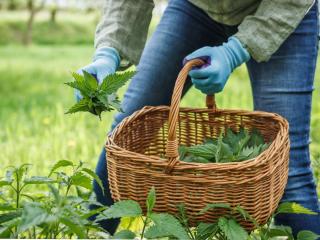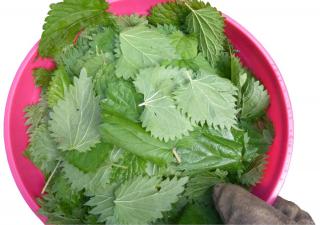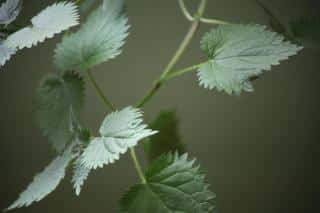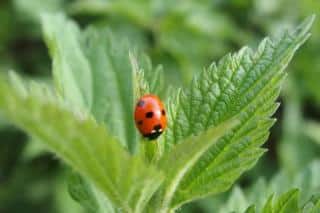

Who hasn’t yet suffered the sting of wild nettle? Far from being a weed, stinging nettle is an excellent ally for organic gardeners, especially for growing tomato!
Continuous use aims to prevent diseases and pests from appearing. More concentrated solutions serve as curative treatment for tomato, too. It makes for great tomato plant fertilizer, and on the side can trigger composting and speed the breakdown of organic matter into useful nutrients. Discover the fabulous virtues of stinging nettle tea and the recipe to prepare it. Clearly you’ll understand why it’s one of the best fermented teas of all!
→ Read also: best way to care for tomato
Here is the recipe so you can protect your tomato plants using stinging nettle:
 First of all, find a lush patch of fresh stinging nettle. They often appear in forest clearings, abandoned plots of land, or – quite often actually – in your own back yard.
First of all, find a lush patch of fresh stinging nettle. They often appear in forest clearings, abandoned plots of land, or – quite often actually – in your own back yard. Wrap this plant material in a cloth pouch, similar to cheesecloth. It’ll make work a lot easier when it comes to sieving the mix.
Wrap this plant material in a cloth pouch, similar to cheesecloth. It’ll make work a lot easier when it comes to sieving the mix.Fermented nettle tea is a natural insecticide that repels certain pests like aphids and mites. Spray leaves (topside and underside) with a 5% solution (95% water).
 Nettle tea can be used preventively to fight against certain fungal diseases. On tomato plants specifically, this even includes hard-to-eradicate blight mildew. It works by boosting the immune systems of the plants themselves, when sprayed on leafage. Again, here too, it must be diluted in a 5% solution.
Nettle tea can be used preventively to fight against certain fungal diseases. On tomato plants specifically, this even includes hard-to-eradicate blight mildew. It works by boosting the immune systems of the plants themselves, when sprayed on leafage. Again, here too, it must be diluted in a 5% solution.
Because fermented nettle tea has extremely high levels of nitrogen and potassium, you can use it to fertilize your tomato plants every Spring. The mixture will spur growth of your tomato plants and strengthen them so they’ll resist diseases better. Use it in the vegetable patch, and also feel free to let ornamental plants benefit from them. Simply spray twice a month with a 10% solution.
Tomato seedlings sown and sprouted? Six inches tall, ready to transplant to the growing bed? Don’t let them miss out on a good, nutritious fermented stinging nettle tea soak! Dunk your young tomato seedlings in a nettle tea solution that contains 20% concentrate and 80% water, just before planting.
High levels of liquid organic matter explain why fermented nettle tea stimulates further breakdown of organic matter. It raises the temperature of the compost, thus activating it. Spray your compost directly with your fermented stinging nettle mix without thinning it down, and turn the pile over. Once fully ripe, compost is an excellent soil conditioner for tomato plants.
 Of course, nettle is plentiful in the wild, but that doesn’t mean you shouldn’t plant it in your own garden. Keep a small patch to the side where you can sow stinging nettle. Nettle can grow most anywhere, but it truly thrives when the substrate is nitrogen-rich. Part shade is ideal. The soil’s nitrogen is what the plant will absorb, and it will give it all back when you use it for fertilizer! Best sow in Spring or Summer.
Of course, nettle is plentiful in the wild, but that doesn’t mean you shouldn’t plant it in your own garden. Keep a small patch to the side where you can sow stinging nettle. Nettle can grow most anywhere, but it truly thrives when the substrate is nitrogen-rich. Part shade is ideal. The soil’s nitrogen is what the plant will absorb, and it will give it all back when you use it for fertilizer! Best sow in Spring or Summer.
This tiny nettle patch will find use even before you harvest it. Many beneficial insects, hoverfly for instance, love finding refuge in it. Thought the spray repels them, live nettle attracts aphids, thus attracting ladybugs which will hunt them down throughout the garden.
A good practice is to harvest your stinging nettle a bit at a time instead of cutting the patch bare, to prepare your fermented tea. Remember to keep some of the fresher leaves for you, too! There are many delicious recipes that make great use of nettle, from cake to soup to pie!
When planting your seedlings, throw a handful of nettle leaves at the bottom of the hole. It’ll break down into nutrients just as the soak dip effects wear off!